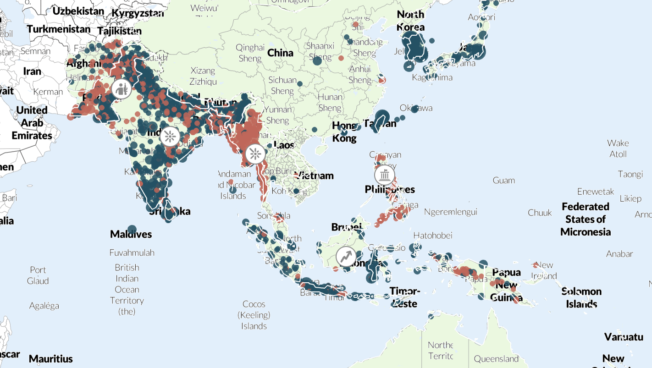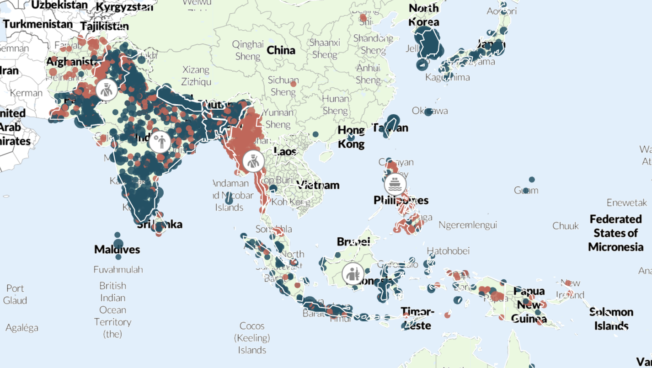Regional Overview
Asia-Pacific
September 2024
Posted: 4 October 2024
In this Regional Overview
- Afghanistan and Pakistan: Border clashes intensify along the Durand Line
- Bangladesh: Sectarian violence increases fears of rising Islamic fundamentalism
- India: Ethnic clashes escalate in Manipur
- Myanmar: Airstrikes target civilians in Rakhine and Shan states
- Papua New Guinea: Tribal violence kills at least 32 people at the Porgera gold mine
Afghanistan and Pakistan: Border clashes intensify along the Durand Line
Tensions between Taliban and Pakistan state forces intensified across the Afghanistan-Pakistan border in September. Cross-border shelling and clashes between Khost province on the Afghanistan side of the Durand Line and Khyber Pakhtunkhwa province in Pakistan resulted in at least eight fatalities, including at least three civilians. Fighting broke out on 4, 7, and 9 September after the Taliban attempted to build checkpoints in Jaji Maidan district in Khost province.1Islamuddin Sajid, ‘Pakistani, Afghan border forces clash over check post construction,’ Anadolu Agency, 5 September 2024; Radio Free Europe, ‘Heavy Fighting Breaks Out Again On Afghan-Pakistan Border,’ 9 September 2024 Further clashes broke out in Khost at the Ghulam Khan port border crossing of Gurbuz district on 19 September, leading to the death of a Taliban member, an Afghan civilian, and two Pakistani forces.2RFE/RL, ‘Clashes between Taliban and Pakistani border guards in Khost frighten local residents,’ 20 September 2024 Reported fatalities in Khost province were the highest since April 2022. The fighting led to the displacement of nearly 2,000 families and the closure of Ghulam Khan, one of the most important border crossing points between the two countries.3Yousaf Mangal, ‘Ghulam Khan crossing closed after clash,’ Pajhwok Afghan News, 20 September 2024 Toward the end of the month, additional clashes also erupted in Nangarhar and Kunar provinces, where the Taliban tried to build border posts, with the Pakistani military allegedly firing missiles at villages in the area of Goshta district in Nangarhar.4Fidel Rahmati, ‘Clashes resume between Afghan Taliban and Pakistani forces in Nangarhar,’ The Khaama Express, 27 September 2024; Sharif Amiry, ‘Two Taliban members killed in clash with Pakistani border forces: Sources,’ Amu, 29 September 2024 Border tensions have renewed since March 2024 as the Taliban and Pakistan have attempted to construct fences and security checkpoints along the contested Durand Line.
Bangladesh: Sectarian violence increases fears of rising Islamic fundamentalism
Sectarian and ethnic violence erupted in Bangladesh last month, renewing fears that the fall of the secular Awami League government has opened up space for Islamic fundamentalists.5Snigdhendu Bhattacharya, ‘Islamic Fundamentalism Raises Its Head in Post-Hasina Bangladesh,’ The Diplomat, 3 September 2024 Much of this violence was targeted against the Sufi community, some of whose practices, such as singing devotional music, are considered to be ‘un-Islamic’ by more orthodox sects.6Laleh-Naz, ‘The scattered legacies of Bengal’s Sufis,’ The Daily Star, 20 November 2023 Over 50 Sufi shrines have been targeted since former Prime Minister Sheikh Hasina’s resignation on 5 August.7Dhaka Tribune, ‘Why attacks on shrines remain rampant in Bangladesh?,’ 15 September 2024 ACLED data show attacks against Sufi places of worship and clashes between Sunni and Sufi Muslims occurring in around eight locations in September. At least one person died during such a clash on 16 September in Kishoreganj district.
Meanwhile, ethnic clashes erupted in the restive Chittagong Hill Tracts (CHT) region after a mob comprising Indigenous people killed a Bengali Muslim settler on suspicion of theft on 18 September. Subsequently, Bengali Muslims, incited by loudspeaker announcements from mosques, carried out retributive attacks, reportedly killing at least four men from ethnic minority groups and vandalizing Buddhist temples. The CHT region has a longstanding history of conflict between the Indigenous communities and Bengali Muslim settlers, many of whom were relocated there by successive governments in alleged attempts to alter the ethnic makeup of CHT.8Abu Jakir and Rezaul Karim Rony, ‘Clashes Erupt in Bangladesh’s Chittagong Hill Tracts,’ The Diplomat, 23 September 2024
India: Ethnic clashes escalate in Manipur
Assailants from the Kuki ethnic group reportedly deployed drones to drop bombs over Koutruk village, which is primarily made up of people from the Meitei ethnic group, on 1 September. Both groups frequently use drones for surveillance purposes. If confirmed, however, the latest attack would be the first time since the conflict began in May 2023 that drones have been used in an offensive capacity. A few days after the attack, suspected Kuki assailants targeted another Meitei settlement with long-range rockets, killing a civilian. The violence continued for the rest of the month, resulting in at least 11 reported fatalities. ACLED data show that September was the deadliest month in Manipur since January 2024. Thousands of Meitei people took to the streets against government inaction in the face of the resurgence in violence, prompting the government to impose a brief curfew and internet shutdown.
Both communities live in near-complete segregation. Thus, violence in Manipur has mainly been concentrated in the peripheral areas between districts primarily inhabited by people from the Meitei and Kuki ethnic groups.9Mayuresh Konnur, ‘Waiting for peace in Indian state divided by violence,’ BBC, 9 August 2024 The use of drones and rockets, which are believed to have an operational range between 500 meters and 15 kilometers, indicates a potential for the violence to spread to other areas.10Firstpost, ‘NSG called in as Manipur faces India’s first drone attack by insurgents,’ 4 September 2024; Ananya Bhardwaj, ‘Around 9 ft & 24 kg with 8-10 km range, improvised rocket bombs emerge as new threat in Manipur,’ The Print, 12 September 2024 Whether the Kuki assailants used weaponized drones remains in doubt: While the state police confirmed the drone attack, the army denied having found any evidence of drones being used to drop bombs. Police are currently investigating the bomb fragments found at the site of the contested attack.11Snehesh Alex Philip, ‘Army has found no evidence of drones dropping bombs in Manipur, say top defence officials,’ The Print, 13 September 2024
Myanmar: Airstrikes target civilians in Rakhine and Shan states
Civilians in Shan and Rakhine states were subject to a barrage of indiscriminate airstrikes in September. These strikes followed a junta warning in early September that they would launch a counterattack against resistance-held territories. This offensive came after the military declared the Brotherhood Alliance a “terrorist” group on 2 September and vowed to recapture the towns it lost to the group.12Al Jazeera, ‘Myanmar regime labels key ethnic armed groups ‘terrorist’ organisations, 4 September 2024; Mizzima, ‘Myanmar’s military council declares Three Brotherhood Alliance a terrorist group,’ 5 September 2024; RFA, ‘Junta offensive underway to recapture towns in northern Shan state,’ 25 September 2024 The Brotherhood Alliance includes the Myanmar National Truth and Justice Party/Myanmar National Democratic Alliance Army, the Palaung State Liberation Front/Ta’ang National Liberation Army (PSLF/TNLA), and the United League of Arakan/Arakan Army (ULA/AA). On 6 September, the military launched an airstrike on Namhkan town near the Myanmar-China border in Shan state, held by PSLF/TNLA, killing at least 11 locals, including two children. This was followed by a deadly airstrike on 9 September in Maungdaw township — where the Rohingya suffered high fatalities last month — that hit a Border Guard Police Battalion captured by the ULA/AA and killed at least 50 people, including war prisoners. ACLED records over 60 military airstrike events targeting civilians this month, resulting in over 100 reported fatalities. Half the airstrike events targeting civilians occurred in Shan and Rakhine states. According to ACLED‘s Conflict Exposure estimates, at least 1,345,603 people were exposed to military airstrikes in Shan and Rakhine states between 1 and 27 September.
Papua New Guinea: Tribal violence kills at least 32 people at the Porgera gold mine
The deadly tribal violence between the Sakar and Piande clans around the Porgera mine in Enga province displaced hundreds in a conflict over unauthorized mining. The five-day clash, which began on 11 September, followed a fight in August where a Piande clan landowner was severely injured during a clash with unauthorized miners from the Sakar clan. Since the crash, authorities have deployed additional security personnel and declared a two-month state of emergency in the area that grants police permission to use lethal force to quell violence.13The National, ‘Emergency in Porgera,’ 23 September 2024; Post-Courier, ‘Police issued orders to disarm threats in Porgera,’ 18 September 2024 Aid delivery remains a challenge as the main road to Porgera continues to be inaccessible after a massive landslide in May.14United Nations in Papua New Guinea, ‘The United Nations in Papua New Guinea strongly condemns the ongoing violence in Porgera, Enga Province and requests the Government to restore security to enable safe humanitarian access and essential services for the affected communities,’ 17 September 2024; Rod McGuirk,’Tribal violence in Papua New Guinea leaves more than 35 people dead, police say,’ ABC News (Australia), accessed on 29 September 2024
ACLED records multiple spikes in violence around the mine in recent years, including in early 2023 and mid-2022, when clashes between Nomali and Aiyala clans led to dozens of deaths. In 2022, Porgera was under a state of emergency for over six months after fierce fighting.15Post-Courier, ‘Marape: Porgera remains under SOE until December,’ 24 June 2022 Since January 2021, ACLED records at least 127 fatalities from political violence in Lagaip and Porgera districts. The population around the mine has grown considerably over the past decades, driven by the arrival of people migrating for work, many of whom have been involved in unauthorized mining.16Tim Swanston and Theckla Gunga, ‘Why the battle over PNG’s Porgera gold mine has been called ‘Game of Thrones … on crack,’ ABC News (Australia), 28 December 2023; Human Rights Watch, ‘Gold’s Costly Dividend: The Porgera Joint Venture,’ 1 February 2011, p. 9 In April 2024, authorities issued an ultimatum to urge unauthorized miners and residents to leave the mine area.17Post-Courier, ‘48 hours notice for Porgera squatters to leave,’ 4 April 2024
See More
See the Codebook and the User Guide for an overview of ACLED’s core methodology. For additional documentation, check the Knowledge Base. Region-specific methodology briefs can be accessed below.
Links:
- Methodology and Coding Decisions for Political Violence and Demonstrations in Afghanistan
- Methodology and Coding Decisions for Political Violence and Demonstrations in China and Taiwan
- Methodology and Coding Decisions for Political Violence and Demonstrations in Myanmar
- Methodology and Coding Decisions for Political Violence and Demonstrations in North Korea







